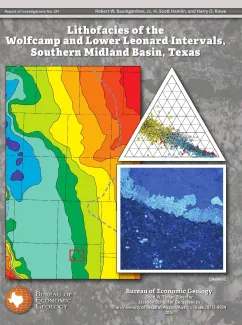
Publication Details
Geolocation:
Get the Publication
$12.50
Abstract/Description:
Basinal mudrocks and associated facies assigned to the Wolfcamp and lower Leonard lithostratigraphic units in the Midland Basin are prolific producers of oil and gas. Four facies are recognized in core on the basis of macroscopic examination, XRD analysis, and ED-XRF elemental chemistry: (1) siliceous mudrock, (2) calcareous mudrock, (3) muddy bioclast–lithoclast floatstone, and (4) skeletal wackestone/packstone. Mudrocks are largely hemipelagic deposits of fine-grained sediment delivered by suspension settling. Floatstones were deposited by debris flows that originated on carbonate shelves around the basin.
Wackestones/packstones are finer grained sediment density-flow deposits, probably turbidites, reworked by local bottom currents. These sediments were deposited below storm wave base in a basin having limited connection to the open ocean. During deposition, low-oxygen conditions prevailed in bottom waters and sediments, as shown by the presence of agglutinated foraminifera, rarity of burrows, widespread prevalence of small (<6 μm) pyrite framboids, presence of phosphatic nodules, and elevated molybdenum concentrations. Total organic carbon (TOC) content reaches 6.8 percent. TOC is facies-dependent (highest in siliceous mudrock) and varies widely within small vertical distances. Cyclicity is evident in individual meter-thick, upward-fining cycles of floatstone or wackestone/packstone overlain by calcareous and siliceous mudrock. Rock strength increases as calcite content increases, likely as a result of diagenetic cementation. Most kerogen in the lower Leonard–Wolfcamp interval is in the oil-production window and has matured to Type II–III (“oil–gas prone”). Based on their TOC and hydrogen content, siliceous mudrocks have the highest potential for hydrocarbon generation.